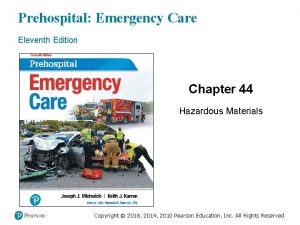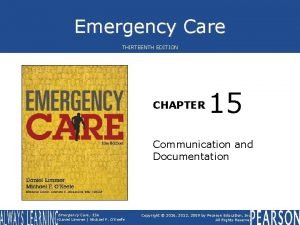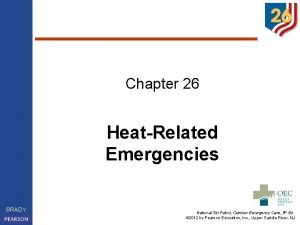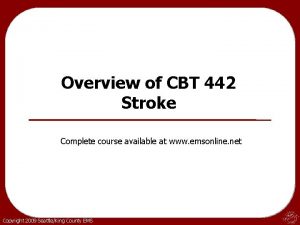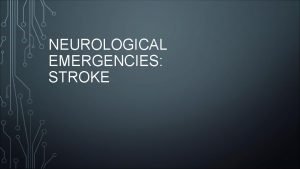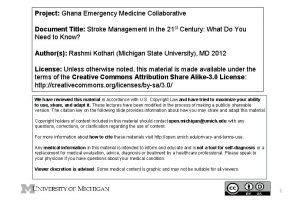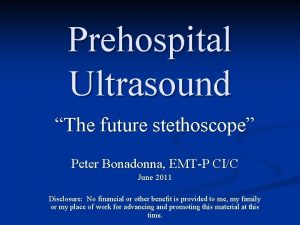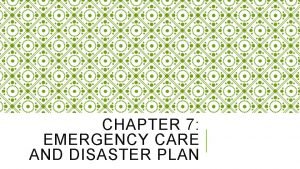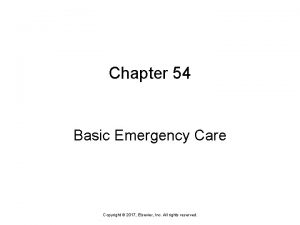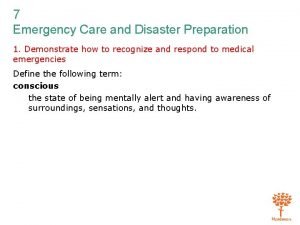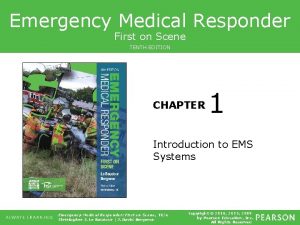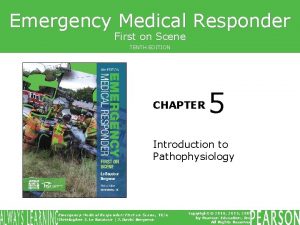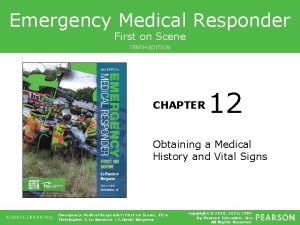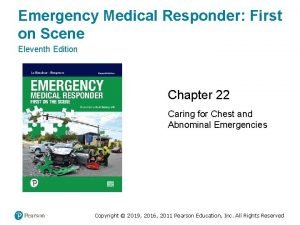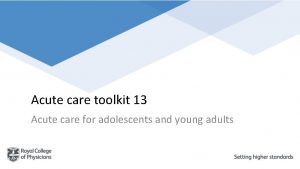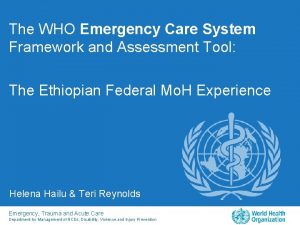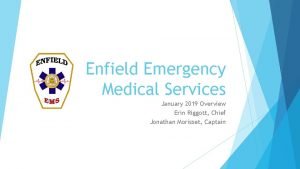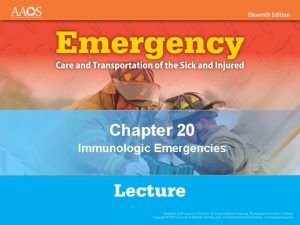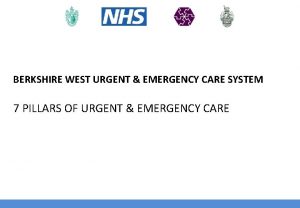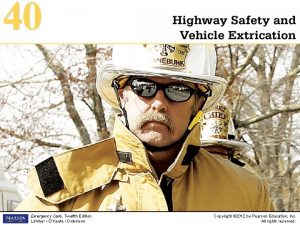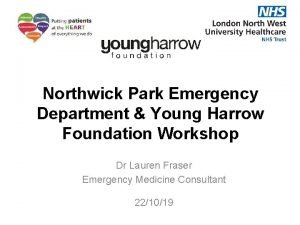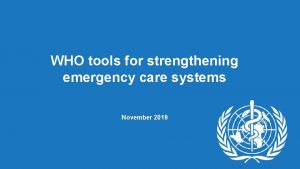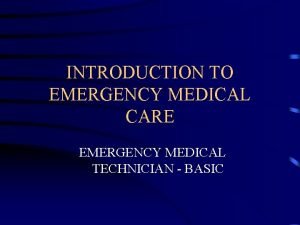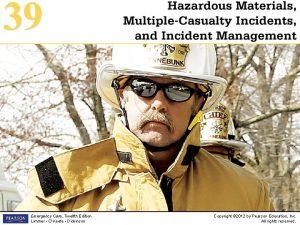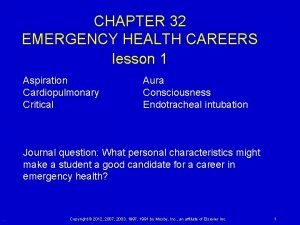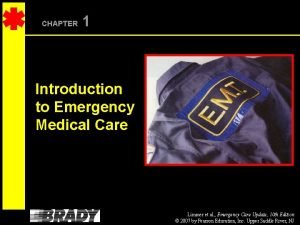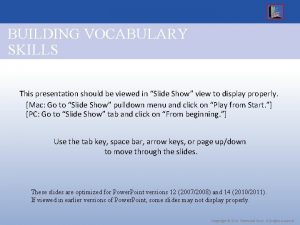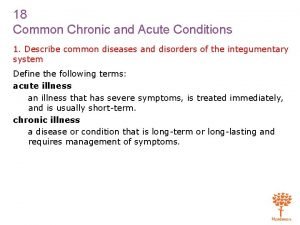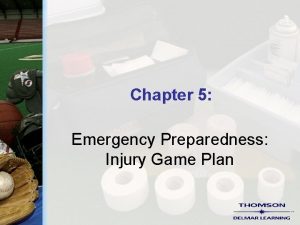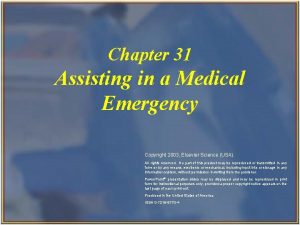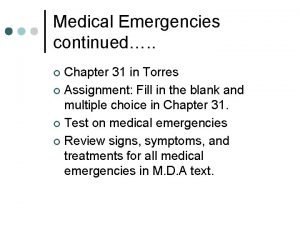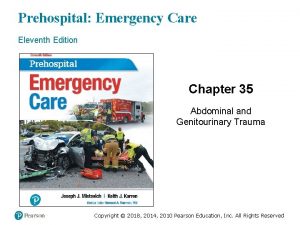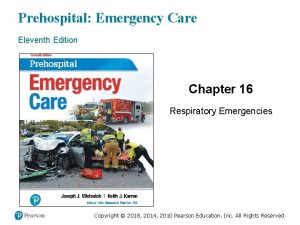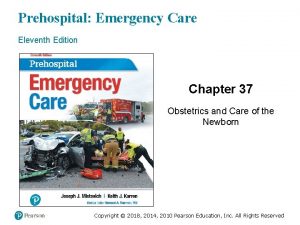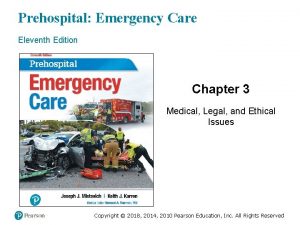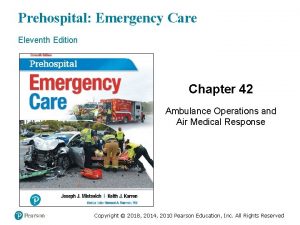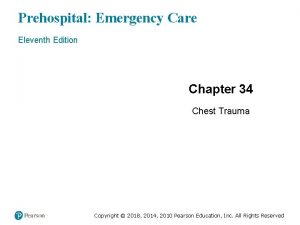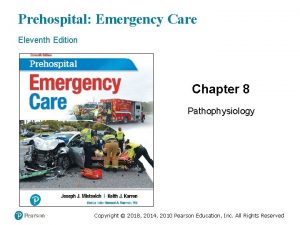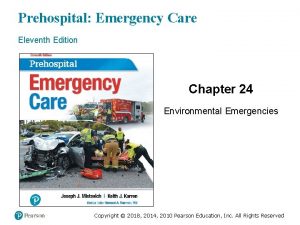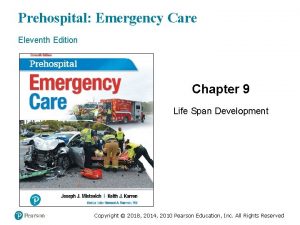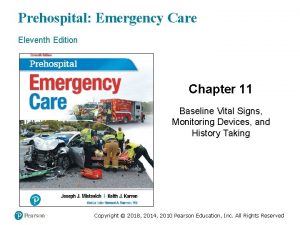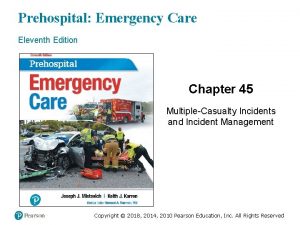Prehospital Emergency Care Eleventh Edition Chapter 20 Acute











































































- Slides: 75

Prehospital: Emergency Care Eleventh Edition Chapter 20 Acute Diabetic Emergencies Slides in this presentation contain hyperlinks. JAWS users should be able to get a list of links by using INSERT+F 7 Copyright © 2018, 2014, 2010 Pearson Education, Inc. All Rights Reserved

Learning Readiness • EMS Education Standards, text p. 603. • Chapter Objectives, text p. 603. • Key Terms, text p. 603. • Purpose of lecture presentation versus textbook reading assignments. Copyright © 2018, 2014, 2010 Pearson Education, Inc. All Rights Reserved

Setting the Stage • Overview of Lesson Topics – Understanding Diabetes Mellitus – Acute Diabetic Emergencies – Assessment-Based Approach: Altered Mental Status in a Diabetic Emergency Copyright © 2018, 2014, 2010 Pearson Education, Inc. All Rights Reserved

Case Study Introduction EMTs Heidi Burr and JD Hudson arrive at the scene of a reported diabetic emergency to find a man in his 20 s sitting in the reception area of an office building, with two coworkers tending to him. The patient seems confused, and appears pale and sweaty. One of the coworkers says, “He was fine this morning, but he started acting strangely about ten minutes ago. ” Copyright © 2018, 2014, 2010 Pearson Education, Inc. All Rights Reserved

Case Study (1 of 3) • What diabetic emergency seems likely, based on the information so far? • What information would you need to confirm your hypothesis? Copyright © 2018, 2014, 2010 Pearson Education, Inc. All Rights Reserved

Introduction • Diabetes can cause changes in mental status related to alterations in blood glucose level. • Acute diabetic emergencies are life threatening. • Prompt recognition and care critical. • Diabetes has serious long-term complications. Copyright © 2018, 2014, 2010 Pearson Education, Inc. All Rights Reserved

Understanding Diabetes Mellitus (1 of 16) • Under normal circumstances, hormones control the blood glucose level. • Diabetic emergencies result from abnormalities in blood glucose control. Copyright © 2018, 2014, 2010 Pearson Education, Inc. All Rights Reserved

Understanding Diabetes Mellitus (2 of 16) • Glucose (Sugar) – Carbohydrates are the primary energy source for cells. – Complex carbohydrates are broken down into simple sugars, primarily glucose, for use by the cells. Copyright © 2018, 2014, 2010 Pearson Education, Inc. All Rights Reserved

Understanding Diabetes Mellitus (3 of 16) • Glucose (Sugar) – Regulation of blood glucose level is critical to normal cell function. – Brain cells can only use glucose for energy, and cannot function when glucose is inadequate. – Low blood glucose results in AMS. – Prolonged low blood glucose leads to brain cell death. Copyright © 2018, 2014, 2010 Pearson Education, Inc. All Rights Reserved

Understanding Diabetes Mellitus (4 of 16) • Glucose (Sugar) – Excess glucose in cells causes water to enter the cell, which worsens head injury or stroke. – With high blood glucose, glucose is excreted in urine, bringing water along with it, leading to dehydration. Copyright © 2018, 2014, 2010 Pearson Education, Inc. All Rights Reserved

Understanding Diabetes Mellitus (5 of 16) • Hormones That Control Blood Glucose Levels – Insulin ▪ Insulin is secreted when blood glucose levels are high. ▪ Without insulin, little glucose can enter the cells. ▪ Glucose remains in the bloodstream, resulting in elevated blood glucose levels. Copyright © 2018, 2014, 2010 Pearson Education, Inc. All Rights Reserved

Glucose Movement into the Cell with Insulin and the Inability of Glucose to Get into the Cell without Insulin Copyright © 2018, 2014, 2010 Pearson Education, Inc. All Rights Reserved

Understanding Diabetes Mellitus (6 of 16) • Hormones That Control Blood Glucose Levels – Glucagon ▪ Secreted when blood glucose level is low ▪ Functions to increase and maintain the blood glucose level Copyright © 2018, 2014, 2010 Pearson Education, Inc. All Rights Reserved

Understanding Diabetes Mellitus (7 of 16) • Hormones That Control Blood Glucose Levels – Other Hormones: Epinephrine ▪ Released when blood glucose levels are very low. ▪ Inhibits insulin secretion and promotes release of stored glucose from the liver. ▪ Some signs and symptoms of hypoglycemia are related to the release of epinephrine. Copyright © 2018, 2014, 2010 Pearson Education, Inc. All Rights Reserved

Understanding Diabetes Mellitus (8 of 16) • Normal Metabolism and Glucose Regulation – The normal range of blood glucose levels is 70 to 120 m g /d L. – Insulin is secreted in response to increased blood glucose levels. – Between meals, blood glucose levels drop, glucagon is secreted to increase and maintain the blood glucose level. illi ram eci itre Copyright © 2018, 2014, 2010 Pearson Education, Inc. All Rights Reserved

Normal Glucose Regulation Copyright © 2018, 2014, 2010 Pearson Education, Inc. All Rights Reserved

Glucose Regulation in Diabetes Mellitus Copyright © 2018, 2014, 2010 Pearson Education, Inc. All Rights Reserved

Understanding Diabetes Mellitus (9 of 16) • Checking the Blood Glucose Level – Testing the Blood Glucose Level with a Glucose Meter. ▪ Normal readings range from 80 to 120 m g /d L. ▪ When interpreting the reading, determine the last time the patient ate or drank anything. illi ram eci itre Copyright © 2018, 2014, 2010 Pearson Education, Inc. All Rights Reserved

Understanding Diabetes Mellitus (10 of 16) • Checking the Blood Glucose Level – Testing the Blood Glucose Level with a Glucose Meter. ▪ Hypoglycemia is a BGL of 70 m g /d L or less with signs and symptoms. ▪ Hyperglycemia is a BGL of 200 m g /d L or higher. illi ram eci illi ram itre eci itre Copyright © 2018, 2014, 2010 Pearson Education, Inc. All Rights Reserved

EMT Skills 20 -1 Testing the Blood Glucose Level with a Glucose Meter Copyright © 2018, 2014, 2010 Pearson Education, Inc. All Rights Reserved

Prepare the Glucose Meter Copyright © 2018, 2014, 2010 Pearson Education, Inc. All Rights Reserved

Clean the Site Copyright © 2018, 2014, 2010 Pearson Education, Inc. All Rights Reserved

Perform the Finger Stick Copyright © 2018, 2014, 2010 Pearson Education, Inc. All Rights Reserved

Waste the First Drop of Blood onto a Dressing. Drop the Second Blood Drop onto the Test Strip Copyright © 2018, 2014, 2010 Pearson Education, Inc. All Rights Reserved

Read the Blood Glucose Value Displayed on the Glucose Meter Copyright © 2018, 2014, 2010 Pearson Education, Inc. All Rights Reserved

Understanding Diabetes Mellitus (11 of 16) • Diabetes Mellitus – A disturbance in the metabolism of carbohydrates, fats, and proteins – Results from: – Lack of insulin secreted from pancreas (OR) – Inability of cell receptors to respond to insulin to allow glucose into the cells Copyright © 2018, 2014, 2010 Pearson Education, Inc. All Rights Reserved

Understanding Diabetes Mellitus (12 of 16) • Diabetes Mellitus – The patient has a high blood glucose level, but the cells are deprived of glucose. – The brain cells do not require insulin to use glucose. – Excess glucose is excreted by the kidneys, causing excess water loss. Copyright © 2018, 2014, 2010 Pearson Education, Inc. All Rights Reserved

Understanding Diabetes Mellitus (13 of 16) • Diabetes Mellitus – The three Ps of diabetes are: ▪ Polydipsia ▪ Polyuria ▪ Polyphagia Copyright © 2018, 2014, 2010 Pearson Education, Inc. All Rights Reserved

Understanding Diabetes Mellitus (14 of 16) • Diabetes Mellitus – Type 1 diabetes ▪ Pancreas does not secrete insulin. ▪ Patients must take insulin to regulate blood glucose. ▪ Peak onset is between 10 -14 years of age. ▪ Patients often have a lean build. ▪ Patients are prone to diabetic ketoacidosis (DKA). Copyright © 2018, 2014, 2010 Pearson Education, Inc. All Rights Reserved

Understanding Diabetes Mellitus (15 of 16) • Diabetes Mellitus – Type 2 diabetes ▪ Patients use oral medication, diet, and exercise, rather than insulin, to manage blood glucose levels. ▪ Patients are usually middle-aged or older, and overweight. ▪ Patients are prone to hyperglycemic hyperosmolar nonketotic syndrome (HHNS). Copyright © 2018, 2014, 2010 Pearson Education, Inc. All Rights Reserved

Understanding Diabetes Mellitus (16 of 16) • Diabetes Mellitus – Diabetics are prone to diseases and disorders of the blood vessels ▪ Heart attack ▪ Stroke ▪ Kidney failure Copyright © 2018, 2014, 2010 Pearson Education, Inc. All Rights Reserved

Click on the Action Below That Results from Release of Insulin A. Glucose enters brain cells in larger quantities than required for cell metabolism. B. Glycogen in the liver is broken down into glucose, increasing the blood glucose level. C. The rate at which glucose is taken up by body cells increases. D. Epinephrine levels are increased, leading to tachycardia, pale skin, and sweating. Copyright © 2018, 2014, 2010 Pearson Education, Inc. All Rights Reserved

Case Study (2 of 3) The patient, whose name is Trent, is confused as to the day of the week, and has difficulty answering other questions, but can follow commands. He is able to confirm a history of diabetes, but it is unclear when he last took insulin or ate. JD obtains a blood glucose reading of 48 m g /d L. illi ram eci itre Copyright © 2018, 2014, 2010 Pearson Education, Inc. All Rights Reserved

Case Study (3 of 3) • Is the patient’s blood glucose level high, low, or normal? • Explain the findings of confusion and pale, diaphoretic skin. • What treatment does this patient require? Copyright © 2018, 2014, 2010 Pearson Education, Inc. All Rights Reserved

Acute Diabetic Emergencies (1 of 21) • Hypoglycemia – Usually occurs in type 1 diabetes – Results from excess insulin that the patient takes to manage their diabetes Copyright © 2018, 2014, 2010 Pearson Education, Inc. All Rights Reserved

Acute Diabetic Emergencies (2 of 21) • Hypoglycemia – Pathophysiology of Hypoglycemia ▪ The patient takes insulin, but does not eat a meal. ▪ The patient takes insulin, eats a meal, and drastically increases their activity. ▪ The patient takes too much insulin. ▪ Can also occur in type 2 diabetics from the effects of oral mediations. Copyright © 2018, 2014, 2010 Pearson Education, Inc. All Rights Reserved

Acute Diabetic Emergencies (3 of 21) • Hypoglycemia – Assessment Findings in Hypoglycemia ▪ Altered mental status occurs from low blood glucose. ▪ Other signs and symptoms occur from epinephrine release. Copyright © 2018, 2014, 2010 Pearson Education, Inc. All Rights Reserved

Acute Diabetic Emergencies (4 of 21) • Hypoglycemia – Assessment Findings in Hypoglycemia ▪ Symptoms related to brain cell dysfunction (low blood glucose) – Confusion, disorientation, or drowsiness – Unresponsiveness – Seizures – Stroke-like symptoms Copyright © 2018, 2014, 2010 Pearson Education, Inc. All Rights Reserved

Acute Diabetic Emergencies (5 of 21) • Hypoglycemia – Hypoglycemia Unawareness ▪ Over time the signs and symptoms of hypoglycemia can change. ▪ This can allow blood glucose levels to drop significantly without intervention. Copyright © 2018, 2014, 2010 Pearson Education, Inc. All Rights Reserved

Acute Diabetic Emergencies (6 of 21) • Hypoglycemia – Emergency care for hypoglycemia ▪ Categorize the patient as: – Unresponsive, unable to swallow, or unable to follow commands; Or – Altered mental status but responsive, able to swallow, and able to follow commands Copyright © 2018, 2014, 2010 Pearson Education, Inc. All Rights Reserved

Acute Diabetic Emergencies (7 of 21) • Emergency care for hypoglycemia – For patients who are unresponsive, unable to swallow, or unable to follow commands ▪ Establish an open airway. ▪ Apply oxygen if the Sp. O 2 is <94%. ▪ Provide positive pressure ventilation if breathing is inadequate. ▪ Assess the blood glucose level. ▪ Request ALS. Copyright © 2018, 2014, 2010 Pearson Education, Inc. All Rights Reserved

Acute Diabetic Emergencies (8 of 21) • Emergency care for hypoglycemia – For patients with altered mental status but responsive, able to swallow, and able to follow commands ▪ Ensure a patent airway. ▪ Assess the blood glucose level. ▪ Administer one tube of oral glucose. Copyright © 2018, 2014, 2010 Pearson Education, Inc. All Rights Reserved

Acute Diabetic Emergencies (9 of 21) • Emergency care for hypoglycemia – Oral glucose ▪ Gel is absorbed quickly, increasing the blood glucose level. – Oral glucose may be administered only if all these patient conditions are met: ▪ Altered mental status ▪ History of diabetes controlled by medication or a B GL <70 mm. Hg ▪ Has the ability to swallow Copyright © 2018, 2014, 2010 Pearson Education, Inc. All Rights Reserved

One Method of Administering Oral Glucose is to Squeeze the Tube of Oral Glucose Between the Patient’s Cheek and Gum Copyright © 2018, 2014, 2010 Pearson Education, Inc. All Rights Reserved

Acute Diabetic Emergencies (10 of 21) • Emergency care for hypoglycemia – Intranasal Glucagon ▪ Glucagon does not contain glucose ▪ Converts glycogen in the liver to glucose ▪ Administer via MAD and syringe ▪ May take 13 to 16 minutes to work Copyright © 2018, 2014, 2010 Pearson Education, Inc. All Rights Reserved

Acute Diabetic Emergencies (11 of 21) • Hyperglycemia – High blood glucose levels caused by a relative lack of insulin – Extreme hyperglycemia may result in: ▪ Diabetic ketoacidosis (DKA) ▪ Hyperglycemic Hyperosmolar Nonketotic Syndrome (HHNS) Copyright © 2018, 2014, 2010 Pearson Education, Inc. All Rights Reserved

Acute Diabetic Emergencies (12 of 21) • Hyperglycemic Condition: Diabetic Ketoacidosis – Pathophysiology of DKA ▪ Blood glucose typically >350 m g /d L. ▪ Without insulin to help move glucose into cells, cells are starved. ▪ Cells begin to burn fat. illi rams eci itre Copyright © 2018, 2014, 2010 Pearson Education, Inc. All Rights Reserved

Pathophysiology of Diabetic Ketoacidosis (DKA) Copyright © 2018, 2014, 2010 Pearson Education, Inc. All Rights Reserved

Acute Diabetic Emergencies (13 of 21) • Hyperglycemic Condition: Diabetic Ketoacidosis – Pathophysiology of DKA ▪ Factors that can lead to DKA – Infection – Inadequate insulin dose – Certain medications – Physical stress (surgery, trauma) – Increase in carbohydrate intake Copyright © 2018, 2014, 2010 Pearson Education, Inc. All Rights Reserved

Acute Diabetic Emergencies (14 of 21) • Hyperglycemic Condition: Diabetic Ketoacidosis – Assessment Findings in DKA ▪ DKA signs and symptoms are produced primarily by the dehydration and acid buildup. ▪ DKA progresses slowly over a few days. Copyright © 2018, 2014, 2010 Pearson Education, Inc. All Rights Reserved

Acute Diabetic Emergencies (15 of 21) • Hyperglycemic Condition: Diabetic Ketoacidosis – Assessment Findings in DKA ▪ S&S related to dehydration are polyuria, polydipsia, poor skin turgor, tachycardia, and positive tilt test. ▪ Nausea, vomiting, and muscle cramps are typically due to electrolyte disturbances from the loss of sodium, potassium, and magnesium. Copyright © 2018, 2014, 2010 Pearson Education, Inc. All Rights Reserved

Acute Diabetic Emergencies (16 of 21) • Hyperglycemic Condition: Diabetic Ketoacidosis – Emergency Care for DKA ▪ Establish and maintain a patent airway. ▪ Administer oxygen if Sp. O 2 <94%. ▪ Positive pressure ventilation, if needed ▪ Determine the blood glucose level. ▪ If you are not sure of the condition, administer oral glucose if the patient can swallow. ▪ Contact medical direction. Copyright © 2018, 2014, 2010 Pearson Education, Inc. All Rights Reserved

Acute Diabetic Emergencies (17 of 21) • Hyperglycemic Condition: Hyperglycemic Hyperosmolar Syndrome – Pathophysiology of HHS ▪ The blood glucose is very high; 600 to 1, 200 m g /d L (hyperglycemic). ▪ Glucose is excreted in urine, with large amounts of water (hyperosmolar effect). illi rams eci itre Copyright © 2018, 2014, 2010 Pearson Education, Inc. All Rights Reserved

Acute Diabetic Emergencies (18 of 21) • Hyperglycemic Condition: Hyperglycemic Hyperosmolar Syndrome – Pathophysiology of HHS ▪ There is enough insulin present to allow use of glucose and prevent ketone production from use of fats for energy (nonketotic). ▪ Carries a high mortality rate. Copyright © 2018, 2014, 2010 Pearson Education, Inc. All Rights Reserved

Pathophysiology of Hyperglycemic Hyperosmolar Nonketotic Syndrome (HHNS) Copyright © 2018, 2014, 2010 Pearson Education, Inc. All Rights Reserved

Acute Diabetic Emergencies (19 of 21) • Hyperglycemic Condition: Hyperglycemic Hyperosmolar Syndrome – Assessment Findings in HHS ▪ HHNS signs and symptoms – Similar to those of DKA. – No significant buildup of ketones in the body and therefore no significant acid load. – No Kussmaul respirations or fruity odor on the breath with HHS. Copyright © 2018, 2014, 2010 Pearson Education, Inc. All Rights Reserved

Acute Diabetic Emergencies (20 of 21) • Hyperglycemic Condition: Hyperglycemic Hyperosmolar Syndrome – Emergency Medical Care for HHS ▪ Establish and maintain a patent airway. ▪ Administer oxygen if the Sp. O 2 is <94%. ▪ Provide positive pressure ventilation if breathing is inadequate. Copyright © 2018, 2014, 2010 Pearson Education, Inc. All Rights Reserved

Acute Diabetic Emergencies (21 of 21) • Hyperglycemic Condition: Hyperglycemic Hyperosmolar Syndrome – Emergency Medical Care for HHS ▪ Check the BGL. ▪ If you are unsure of the condition, administer glucose, if the patient can swallow. ▪ Contact medical direction. Copyright © 2018, 2014, 2010 Pearson Education, Inc. All Rights Reserved

Table 20 -2 Signs and Symptoms of Diabetic Emergency Conditions (1 of 2) Sign or Symptom DKA HHS Hypoglycemia Onset Slow, over days Sudden, over minutes Heart rate Tachycardia Blood pressure Low Normal Respirations Kussmaul Normal or shallow Breath odor Sweet and fruity None Mental status Coma (very late) Confusion Bizarre behavior, agitated, aggressive, altered, unresponsive Oral mucosa Dry Salivation Thirst Intense Absent Vomiting Common Uncommon Abdominal pain Common Uncommon Absent Insulin level Low High Blood glucose level High greaterthan 350 miligram per deciliter Very high greaterthan 700 miligram per deciliter Very low less than 70 miligram per deciliter Copyright © 2018, 2014, 2010 Pearson Education, Inc. All Rights Reserved

Table 20 -2 Signs and Symptoms of Diabetic Emergency Conditions (2 of 2) Emergency Care and Patient Needs DKA HHS Hypoglycemia Basic care Supportive and glucose ALS care Fluids IV glucose, IM glucagon Patient needs Insulin Glucose Copyright © 2018, 2014, 2010 Pearson Education, Inc. All Rights Reserved

Assessment-Based Approach: AMS in A Diabetic Emergency (1 of 6) • Scene Size-Up and Primary Assessment – Look for medical alert tags, tattoos, or other medical identification. ▪ An insulin pump is a clue to diabetes. Copyright © 2018, 2014, 2010 Pearson Education, Inc. All Rights Reserved

A Medical Identification Tag May Indicate That the Patient is a Diabetic Copyright © 2018, 2014, 2010 Pearson Education, Inc. All Rights Reserved

Assessment-Based Approach: AMS in A Diabetic Emergency (2 of 6) • History and Secondary Assessment – Sample – Especially ask about medications taken for diabetes. Copyright © 2018, 2014, 2010 Pearson Education, Inc. All Rights Reserved

Assessment-Based Approach: AMS in A Diabetic Emergency (3 of 6) • History and Secondary Assessment – Ask the following: ▪ Has the patient taken their medication? ▪ Has the patient eaten their regular meals? ▪ Has the patient vomited? ▪ Has the patient had any unusual physical activity? Copyright © 2018, 2014, 2010 Pearson Education, Inc. All Rights Reserved

Assessment-Based Approach: AMS in A Diabetic Emergency (4 of 6) • History and Secondary Assessment – Signs and Symptoms: ▪ Elderly patients frequently suffer signs and symptoms that mimic a stroke, such as weakness or paralysis on one side of the body. Keep in mind that some medications (beta blockers) can hide the signs of hypoglycemia. Copyright © 2018, 2014, 2010 Pearson Education, Inc. All Rights Reserved

Assessment-Based Approach: AMS in A Diabetic Emergency (5 of 6) • Emergency Medical Care – Establish and maintain an open airway. – Administer oxygen if the Sp. O 2 is <94%. – Provide positive pressure ventilation if breathing is inadequate. – If the patient is able to swallow and has a low blood glucose level, administer oral glucose. – Transport. Copyright © 2018, 2014, 2010 Pearson Education, Inc. All Rights Reserved

Assessment-Based Approach: AMS in A Diabetic Emergency (6 of 6) • Reassessment – Determine if the administration of glucose has improved the mental status. – This may take as long as 20 minutes. – If the mental status does not improve: ▪ Consult medical direction about administering more glucose. ▪ Consider other causes of altered mental status. Copyright © 2018, 2014, 2010 Pearson Education, Inc. All Rights Reserved

Case Study Conclusion The patient meets criteria in the EMTs’ protocol for administering oral glucose. JD administers the oral glucose, and they prepare Trent for transport to the hospital. En route, JD continues to monitor Trent’s airway and mental status, and he begins to see some improvement in Trent’s mental status as they arrive at the hospital. Copyright © 2018, 2014, 2010 Pearson Education, Inc. All Rights Reserved

Lesson Summary (1 of 2) • Diabetes is a problem related to regulation of blood glucose level. • Hypoglycemia is a state of low blood glucose levels. • Oral glucose may be indicated in hypoglycemic patients. Copyright © 2018, 2014, 2010 Pearson Education, Inc. All Rights Reserved

Lesson Summary (2 of 2) • Hyperglycemic problems result from a relative lack of insulin. • Type 1 diabetics are prone to DKA. • Type 2 diabetics are prone to HHNS. Copyright © 2018, 2014, 2010 Pearson Education, Inc. All Rights Reserved

Correct! Two functions of insulin are to increase the rate at which glucose enters cells in the body and to allow the liver to store excess glucose in the form of glycogen. In doing so, the effect of insulin is to lower the blood glucose level. Click here to return to the program Copyright © 2018, 2014, 2010 Pearson Education, Inc. All Rights Reserved

Incorrect (1 of 3) Glucose readily enters brain cells without insulin, although other cells in the body require insulin for sufficient amounts of glucose to enter. Click here to return to the quiz Copyright © 2018, 2014, 2010 Pearson Education, Inc. All Rights Reserved

Incorrect (2 of 3) One of the functions of insulin is to promote the storage of excess glucose in the liver as glycogen. Click here to return to the quiz Copyright © 2018, 2014, 2010 Pearson Education, Inc. All Rights Reserved

Incorrect (3 of 3) Epinephrine is released when blood glucose levels are very low. Its release promotes the release of glucose from the liver, as well as the release of insulin. Click here to return to the quiz Copyright © 2018, 2014, 2010 Pearson Education, Inc. All Rights Reserved

Copyright © 2018, 2014, 2010 Pearson Education, Inc. All Rights Reserved
 Prehospital care 11th edition
Prehospital care 11th edition The standards of prehospital emergency care
The standards of prehospital emergency care Pre-hospital communication
Pre-hospital communication Prehospital emergency care 11th edition
Prehospital emergency care 11th edition Prehospital emergency care 11th edition
Prehospital emergency care 11th edition Prehospital emergency care 11th edition
Prehospital emergency care 11th edition Eleventh edition management
Eleventh edition management Management 11th edition by stephen p robbins
Management 11th edition by stephen p robbins Management eleventh edition
Management eleventh edition Management eleventh edition
Management eleventh edition Emergency care 13th edition
Emergency care 13th edition Outdoor emergency care 6th edition
Outdoor emergency care 6th edition Bhore committee
Bhore committee Eleventh 5 year plan
Eleventh 5 year plan 11th five year plan
11th five year plan For his eleventh birthday elvis presley
For his eleventh birthday elvis presley Cincinatti stroke scale
Cincinatti stroke scale Lams stroke scale
Lams stroke scale Cincinnati prehospital stroke scale
Cincinnati prehospital stroke scale Best prehospital stethoscope
Best prehospital stethoscope Chapter 7 emergency care and disaster preparation
Chapter 7 emergency care and disaster preparation Chapter 54 basic emergency care
Chapter 54 basic emergency care Emergency care first aid and disasters
Emergency care first aid and disasters Chapter 7 emergency care and disaster preparation
Chapter 7 emergency care and disaster preparation Levels of care primary secondary tertiary
Levels of care primary secondary tertiary Emergency medical responder first on scene 10th edition
Emergency medical responder first on scene 10th edition Cardiopulmonary
Cardiopulmonary Antecubital
Antecubital Emergency medical responder first on scene 11th edition
Emergency medical responder first on scene 11th edition Acute care collaboration
Acute care collaboration Acute care toolkit
Acute care toolkit Patho
Patho Using mis 10th edition
Using mis 10th edition Mis
Mis Who emergency care system framework
Who emergency care system framework Emergency care and first aid ppt
Emergency care and first aid ppt Emergency care enfield
Emergency care enfield Care for a victim of an immunologic emergency
Care for a victim of an immunologic emergency 7 pillars of urgent and emergency care
7 pillars of urgent and emergency care Golden rules of emergency care
Golden rules of emergency care Introduction to emergency medical care
Introduction to emergency medical care Emergency care harrow
Emergency care harrow Who emergency care system framework
Who emergency care system framework Introduction to emergency medical care
Introduction to emergency medical care Introduction to emergency medical care
Introduction to emergency medical care The goal of modern emergency care includes
The goal of modern emergency care includes Emergency care limmer
Emergency care limmer Introduction to emergency medical care
Introduction to emergency medical care Chapter 10 ten words in context answer key
Chapter 10 ten words in context answer key 18 common chronic and acute conditions
18 common chronic and acute conditions Chapter 5 emergency preparedness injury game plan
Chapter 5 emergency preparedness injury game plan Chapter 36 emergency preparedness and protective practices
Chapter 36 emergency preparedness and protective practices Chapter 31 assisting in a medical emergency
Chapter 31 assisting in a medical emergency Chapter 36 emergency preparedness and protective practices
Chapter 36 emergency preparedness and protective practices Define medical emergency chapter 31
Define medical emergency chapter 31 Care certificate duty of care
Care certificate duty of care Polii magnetici de acelasi nume se
Polii magnetici de acelasi nume se Palliative care versus hospice care
Palliative care versus hospice care Clasificarea mamiferelor dupa modul de hranire
Clasificarea mamiferelor dupa modul de hranire Care sunt simturile prin care sunt evocate
Care sunt simturile prin care sunt evocate Standard 1 care certificate answers
Standard 1 care certificate answers Hip fracture care clinical care standard
Hip fracture care clinical care standard Health and social care unit 2
Health and social care unit 2 Organizational behavior 18th edition
Organizational behavior 18th edition Thermodynamic vs kinetic control
Thermodynamic vs kinetic control Mechanics of materials
Mechanics of materials Mechanics of materials 6th edition beer solution chapter 7
Mechanics of materials 6th edition beer solution chapter 7 Mechanics of materials 6th edition beer solution chapter 6
Mechanics of materials 6th edition beer solution chapter 6 Mechanics of materials chapter 5 solutions
Mechanics of materials chapter 5 solutions Mechanics of materials chapter 10
Mechanics of materials chapter 10 Summary of chapter 1 everything's an argument
Summary of chapter 1 everything's an argument Ifsta 7th edition chapter 6
Ifsta 7th edition chapter 6 Engineering economy 16th edition solution manual chapter 5
Engineering economy 16th edition solution manual chapter 5 Engineering economy 16th edition chapter 4 solutions
Engineering economy 16th edition chapter 4 solutions Business essentials 12th edition
Business essentials 12th edition Cannon bard theory
Cannon bard theory





